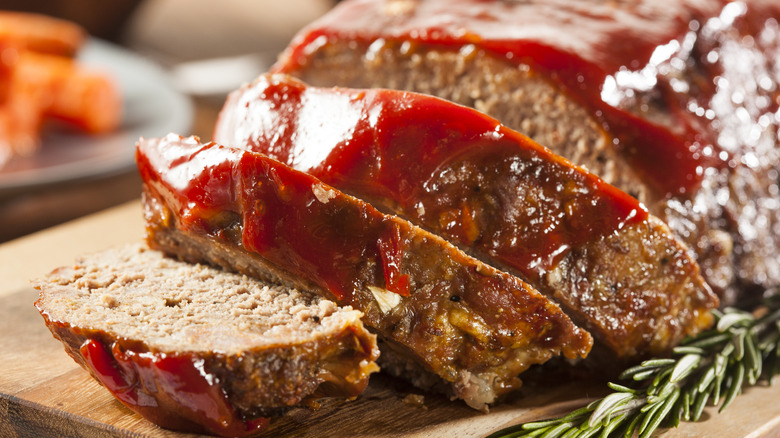How To Make Your Meatloaf Way Better With This Store-Bought Snack
One of the great things about meatloaf, America's favorite dinner, is how adaptable it is. The basic formula is protein, a binder, and some form of liquid for moisture — but there's so much flexibility in each category when making the best basic meatloaf. The protein can be basically any ground meat product, for instance, ranging from hamburger to ground turkey to something more exotic like bison — you just need to follow the best lean-to-fat ratio, which is typically 80/20. There are lots of options for the binding element, too. Along with egg, which many meatloaf recipes call for, many people favor mixing in breadcrumbs, while others use instant potato flakes, and still others swear by oats. But another tasty and incredibly effective candidate may be sitting on your pantry's snack shelf: Ritz crackers. Crushed up and mixed in, this snack-time staple amplifies meatloaf in various ways.
To get the skinny on this outside-the-box ingredient, one of many that can seriously upgrade your homemade meatloaf, Food Republic spoke with David Davidov, recipe developer and creator of The Cooking Foodie. "Ritz crackers bring two things to the table: buttery richness and better moisture retention," Davidov shared. That famous, buttery Ritz flavor that has made it a go-to snack for almost a century lends its toasty tastiness to meatloaf and "enhances the savory notes in the meat without overpowering it," he detailed. Ritz crackers also improve a meatloaf's texture. "They break down into a softer crumb as they hydrate, so the final texture feels lighter and more cohesive," he described.
While breadcrumbs are one of the most common binders used in meatloaf, they "tend to behave like a neutral binder," he added, "but Ritz add both flavor and fat, which keeps the meatloaf tender instead of dense or dry."
Incorporating Ritz crackers into your meatloaf
When adding Ritz crackers into your meatloaf mixture, the size of the cracker bits will affect the final outcome. Crushing or food-processing them into a fine powder will give your loaf "a tighter, more uniform texture (good if you're aiming for a slice-clean meatloaf)," David Davidov explained, while "[slightly] coarse crumbs give small pockets that trap moisture and create a more tender bite." He favors somewhere in between coarse and fine when making meatloaf. "In most cases, that middle ground works best: It binds without turning pasty and still lets the meatloaf feel juicy," he noted.
Making a panade is also a good approach for incorporating the crackers, which is mixing the crushed crackers with milk or another liquid, like broth. This not only helps bind the meat and other loaf ingredients but also helps create a tender and moist final dish. The starches in a panade combat the meat's tendency to lose moisture and shrink up, and the starches simultaneously absorb moisture and retain it.
In terms of the best meats to pair with a Ritz cracker add-in, ground beef, as well as meat blends, like a combination of beef, veal, and pork, are particularly good to let the crackers shine, Davidov suggested. Leaner meats, like turkey and bison, also "[benefit] from the extra fat and flavor," he detailed.
He added that the incorporation of Ritz is especially good in meatloaf recipes that are on the rich or sweet side, "like [barbecue] meatloaf or caramelized onion meatloaf, because they round out the flavors." Traditional meatloaf recipes that call for things like Worcestershire sauce, onion, and a ketchup-based topping are also a good fit, as "the buttery crackers amplify the savory-sweet balance."


